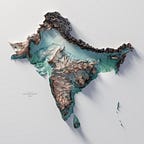Goutamkumar Oinam (Public Domain)
Pakhangba — The Dragon born to Mother Earth
Guardian of Virtue, Vanquisher of Vice
In the classical Meitei mythology, which is the traditional lore of ancient Kangleipak (Manipur), and within the spiritual framework of Sanamahism, a religion that venerates the divine, Pakhangba emerges as a figure of paramount importance, revered as both the guardian and sovereign of the cosmos. This primordial deity is distinguished by his lineage as the youngest offspring of Leimarel, who is venerated as the supreme mother earth goddess, embodying the nurturing and life-giving essence of the planet.
Numerous myths and tales are woven around Pakhangba’s enigmatic persona, with some narratives even intertwining him with illustrious historical figures, blurring the lines between myth and history.
A renowned episode from the annals of history is the ascension of Nongta Lailen Pakhangpa (alias Nongda Lairen Pakhangba), who is celebrated as the inaugural Emperor of the Ningthouja dynasty, to the prestigious throne of Kangla, the erstwhile capital city of Kangleipak dominion, in the year 33 CE. For a span of a thousand years, this emperor was universally acknowledged and revered by scholars and minstrels alike as the earthly embodiment of the celestial serpent deity.
Approximately 3500 years ago, the realm of Ancient Kangleipak, was governed by Emperor Tangja Leela Pakhangba, whose reign spanned from 1445 BCE to 1405 BCE. Historical records and artifacts suggest that the worship of the dragon deity was already an established tradition during his time.
In today’s contemporary society, Pakhangba stands out as an extraordinary and formidable dragon, bearing striking similarities and parallels to the likes of Typhon from Greek mythology, Bahamut from Arabian lore, the Nagas of Hindu tradition, and Quetzalcoatl from the mythology of the indigenous peoples of the Americas.
Goutamkumar Oinam (Public Domain)
In comparison to the myths of the Ancient Greeks, both Pakhangba and Typhon are the youngest sons of Mother Earth Goddess, Leimarel and Gaia respectively. Both are so fearsome and powerful than they have the ability to rule tyranny in the entire world though they never did it.
When juxtaposed with the ancient Greek myths, Pakhangba and Typhon share a common origin as the youngest progeny of the Earth Goddesses, Leimarel Sidabi and Gaia, respectively. Both are depicted as entities of immense power and terror, possessing the capability to establish dominion over the world through tyranny.
In terms of similarity to the Nagas of Hinduism, Pakhangba is characterized as a serpent and possesses the remarkable ability to metamorphose or alter his form, transitioning seamlessly between his serpentine shape and a divine human form, and vice versa.
Concluding with a comparison to Quetzalcoatl of the native Americans, Pakhangba is similarly revered as a primordial patron deity linked with wisdom. Both deities are celebrated for their ability to assume human characteristics in certain narratives.
In my final tribute, I exalt you, O Mighty Pakhangba! The Sovereign of the Cosmos!
Goutamkumar Oinam (Public Domain)
Notes:
- Pakhangba is also spelled as Pakhangpa.
- Leimarel (derived from Ancient Meitei word “Leimalel”) is also spelled as Leimaren (derived from Ancient Meitei word “Leimalen”).
- “Sidabi” (or “Shidabi”) is derived from Ancient Meitei word “Sitapi” (or “Shitapi”).
Special Notes:
* In linguistic, ethnic as well as cultural aspects, Meitei is synonymous with Meetei, Mitei, Meithei, Manipuri, Kanglei, Poirei, etc.
* Traditional Meitei ethnic religion is also known as Sanamahism (or Sanamahi religion), Sannamahism (or Sannamahi religion), Lainingthouism (or Lainingthou religion), Kangleism, Meiteism, Meeteism, Miteism, Meitheism, Manipurism, etc.
* In religious aspect, a believer or a follower or a theologist of the traditional Meitei religion is known as Sanamahist, Sannamahist, Lainingthouist, Kangleist, Meiteist, Meeteist, Miteist, Meitheist, Manipurist, etc.
* Ancient land of the Meitei speaking people (alias Manipuri speaking people) is known as Kangleipak, Meiteileipak, Meeteileipak, Miteileipak, Meiteileibak, Meeteileibak, Miteileibak, Meitrabak, Poireilam, Tilli Koktong, Leikoilel, Leikoilen, Sanaleipak, Sanaleibak, Sannaleipak, Sannaleibak, etc. In present day, most of its parts is located in what we now call Manipur state, with few others in the state's neighboring places.
* In English terms, the Meitei realm is also known as Meiteidom, Meeteidom, Miteidom, Meitheidom, Manipuridom, Kangleidom, Meiteisphere, Meeteisphere, Miteisphere, Meitheisphere, Manipurisphere, Kangleisphere, etc.
